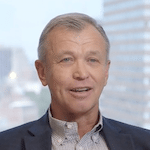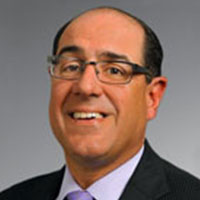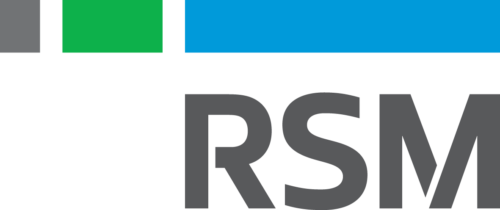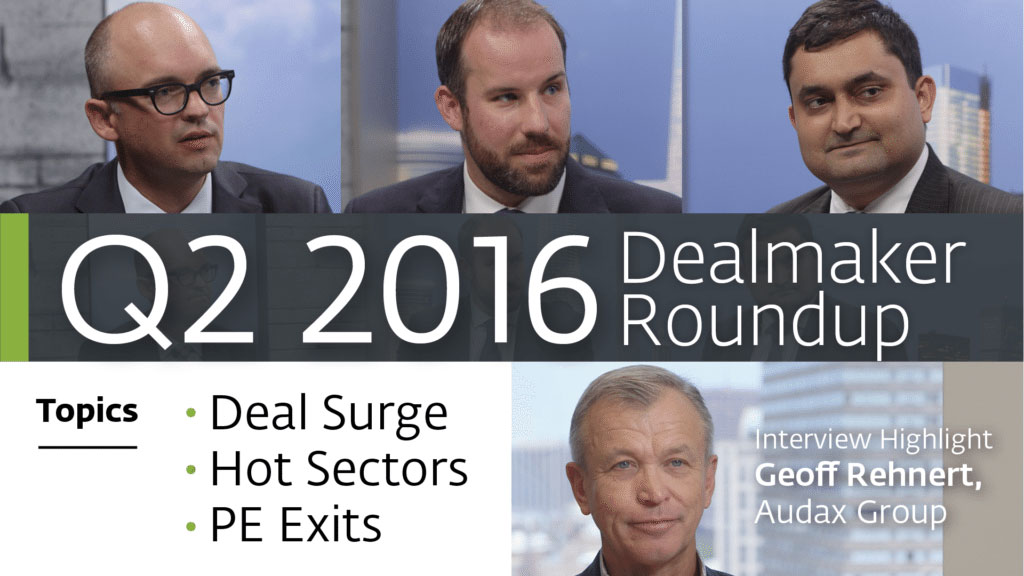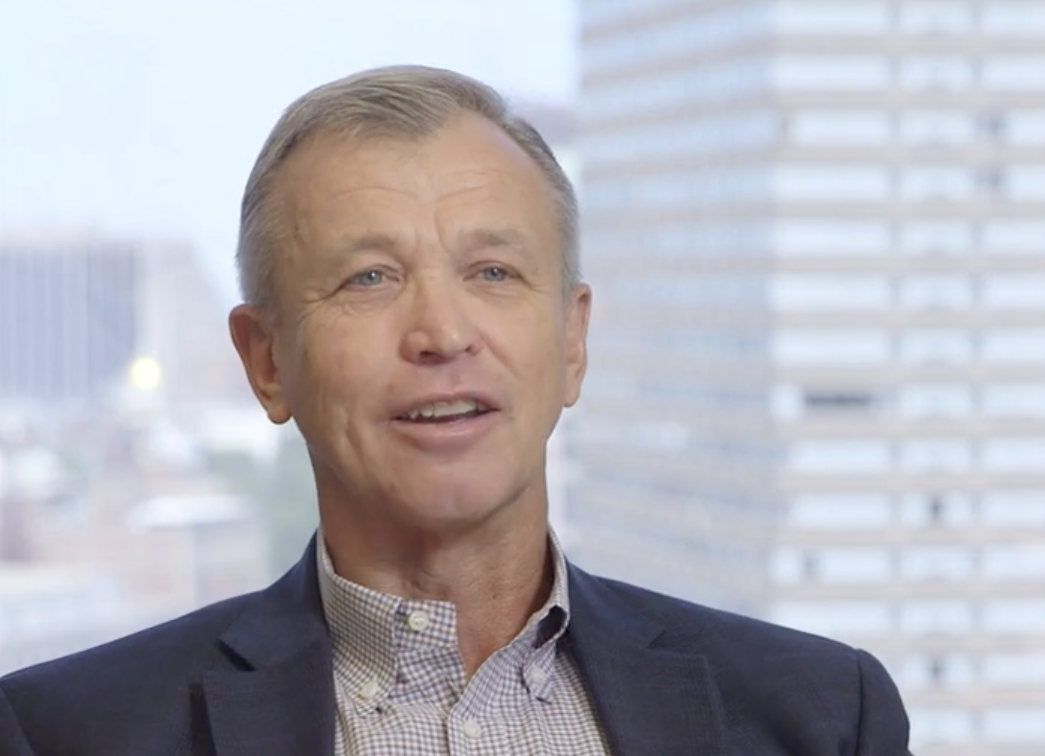Audax Group’s Rehnert: ‘What I’ve Learned’
In a wide-ranging interview, middle-market veteran Geoff Rehnert gives an overview of his career, the changing nature of both the private equity landscape and US corporate competition, what he’s learned from overseeing 500 add-on acquisitions, and that time Mitt Romney looked ready to wring his neck.
Transcript Download Transcript
An Interview with Geoff Rehnert, Audax Group
Dealmaker Dialogue Interview Series
Geoffrey Rehnert, Audax Group: Mitt was looking at me like he was ready to wring my neck, and I’m thinking, oh, geez.
Don Lipari, RSM: We’re joined today by Geoff Rehnert, Co-CEO of Audax Group. Welcome, Geoff.
Geoff: Thank you.
Don: Geoff, in preparation for this interview, I’ve been reading a bit about your career, and it’s a truly storied career. Why don’t we recap briefly, and take a little walk, if you could, on a linear timeline, just take a little walk from Bain & Company, Bain Capital, and now Audax?
Geoff: I joined Bain & Company coming out of Stanford Law School.
About a month into my career, Mitt Romney and Coleman Andrews, the two vice presidents Bill Bain had asked to help found this internal venture capital group that Bain & Company was trying to get off the ground, that they were calling Bain Capital, they were at the Palo Alto office.
Coleman asked me if I wanted to join Bain Capital as one of the two first associates. I took all of about three minutes to think it over, and said yes.
So spent the first 15 years of my career at Bain Capital. Initially there were seven of us. For those of you who saw the picture that, when Mitt was running for president, had guys with $20 bills in their mouths hamming it up after we raised our first fund, that was the initial group of the seven of us. That picture seemed like a good idea at the time. I don’t think Mitt thought it was such a good idea in 2012 when it got played all over the internet, and sort of trying to characterize him as a rich guy flaunting his wealth. At the time, none of us had any money, and I think we had to all borrow the $20 bills and stick them in our mouths so that we could ham it up, but…
We started with a pool of 37 million; that was our first fund in 1984. It was the largest first time fund that had ever been raised at that point. It’s hard to believe, in 1984 there was a total of only about a billion seven of capital in venture capital and leveraged buyouts, and where private equity didn’t even exist, and there were maybe a hundred firms. The good news is we got lucky on a couple of deals, and that first fund was very successful. But it was a very interesting 15 years at Bain Capital as we grew and evolved.
Don: Bain is a great story, and if you look at some of the transactions, household names that Bain was involved in through its history to date, it’s really a who’s who in Corporate America. Which one brings a smile to your face as you reflect on your Bain years?
Geoff: There’s a lot that bring smiles to the face. We were fortunate to find some good investment opportunities. Tom Stemberg, the founder of Staples, actually finished the business plan in our office, and we helped him open the first store. One of our analysts was stocking shelves with him as it opened up over in Brighton.
Our first buyout was a company called Calumet Coach Company, that was based just south of Chicago in Calumet City, Illinois. That wound up being a very successful investment. We made 35 times our money on the transaction in a little over two years. So we wound up returning that whole first fund just on that one investment.
Don: On that one deal.
Geoff: And that was a deal that I was lucky enough to find. I brought Mitt out with me to help with the negotiations with the entrepreneur. The entrepreneur was kind of a crusty character, so the first round didn’t go so well. We wound up getting a deal done, and the day after the deal, when we went to see what we had acquired, a couple of the managers decided to have some fun with Mitt and me, and sort of said, geez, you know, why did you buy this company? There’s no customers, like this…And Mitt was looking at me like he was ready to wring my neck, and I’m thinking, oh, geez. And then the guys broke out laughing. They were playing a practical joke, but…I had a few uneasy moments there, and a few…I think Mitt’s stare burned the back of my shirt as he was glaring at me.
Don: Well, you know, had a lot on the line, and so…
Geoff: All the partners at Bain & Company had invested their own money, plus they viewed the reputation of Bain & Company as being on the line with Bain Capital. The last thing they wanted to do was be the consulting firm associated with a venture capital or buyout firm that lost money.
Don: What caused you to leave Bain and start Audax?
Geoff: So back in 1999, Mitt had decided he was going to leave Bain Capital to go run the Salt Lake City Olympics. So there was a lot of uncertainty about what the leadership of Bain Capital was going to be.
All of the rest of our colleagues at that point wanted to go do large cap private equity; wanted to take Bain Capital out of the middle market where most of our investing activity had happened during the 15 years I was there.
I like the middle market. I actually enjoy the owner entrepreneurs, and the relationships, and I just felt that my skill set and Mark’s skill set lent itself to being able to work with middle market companies and make them into better businesses. And it felt to both Mark and me this was an opportunity to go start our own firm. We both had an entrepreneurial bent.
I never saw myself as working for someone else for very long as a young person. I worked for 15 years for Mitt at Bain Capital, and that’s a testament to his leadership and management capabilities. I saw his taking this leave of absence as a real opportunity to go do something and give it a shot on my own.
Don: In 2015, the firm completed its 500th add-on transaction. You’ve given a little insight as to how you successfully are able to integrate so many firms. You know, I have experienced at RSM going through integrations, and there’s a lot of blood, sweat and tears to get an integration done, so that you actually realize the synergies that you had anticipated when you looked at the two coming together, to become greater than the parts, right?
I know there’s no pixie dust in this society. There’s no bippity, boppity, boop magic wand. So how do you guys complete so many add-on transactions successfully? What secret sauce does Audax apply to get these add-ons to realize the synergies that you anticipate?
Geoff: Well, if there was a secret sauce, I couldn’t tell you. If I told you I’d have to kill you.
Don: Then it wouldn’t be a secret.
Geoff: And I wouldn’t do it on video, so…
Don: Thank you.
Geoff: But, yeah, there’s no secret sauce. It’s a lot of hard work. And we’ve just sort of built on that as time has gone by, and, I think, have refined our systems and processes so that we’re able to identify which platforms are well-suited for our strategy, and then we work closely with the management teams to execute that strategy.
Don: Okay. Let’s take the plane a little higher, and look at the PE landscape. Talk a little bit about past, present and look out onto the horizon in the future of private equity.
Geoff: If you look at the landscape of US business in the mid-1980s, it was still pretty sloppy in general. American business had dominated the global economy after World War II, and started having some challenges in the seventies, with hyperinflation, and the oil crises. In the early 1980s was when they really first started…US businesses really first started confronting foreign competition. Japanese imports, and Germany, and other countries were starting to compete in US markets, and that was putting a lot of pressure on businesses.
Today, in 2016, much of Corporate America, and particularly the middle market, where I’ve spent virtually all of my career in the middle market, the businesses are much better run. And so, as an investor, to make money as a private equity investor, we have to do something above and beyond what we could do 15 years ago, or 30 years ago with these companies to make money. You have to have a systematic way to add value and create value to generate top returns in this industry.
Don: With so much capital committed to private equity, it’s more and more complicated to differentiate yourself in the marketplace.
Geoff: Absolutely.
Don: And when there’s too many dogs chasing too few cats, valuations have a tendency to stay high.
Geoff: Now, I will say, I’ve been in the business now 32 years. And every year, starting in 1985, actually, late ’84, I have heard the common wisdom being that there’s too much money chasing too few deals. So every year that’s what people have said, relative to the prior year. So it’s economics 101, you know. If demand is high, supply keeps increasing to meet that demand. And the supply of capital has increased every single year; the total amount of capital under management has increased every single year I’ve been in the business.
Don: Let’s talk about the regulatory environment today that exists in the US, in particular how it affects Audax. Now, you’re lenders, so the banking regulatory environment should be beneficial to you as banks have to…
Geoff: Yeah, the tier…
Don: …be much more careful about the loans that they make.
Geoff: The tier one capital requirements have really led to a mass exodus of the banks from the middle market, senior loan market. And so our senior loan business is one of many entities that is helping to fill that void and provide capital to borrowers that in the past would’ve most likely gone to banks for that capital.
Don: Talk about the regulatory environment as it relates to the private equity business. How have you dealt with the requirements under the registration currently?
Geoff: There’s an enormous amount of time and energy put into compliance. We actually have three people in our compliance department.
We have seven lawyers on staff fulltime. Here in Boston we have three of them spending a majority of their time on compliance related issues, and…Is it a good thing? I think, ultimately, it probably is a good thing for the industry, because in looking back there had been practices that, theoretically, sophisticated institutional investors ought to have negotiated for protection. But I think the SEC has actually brought a level of clarity as to what the ground rules are, and made more explicit the need to disclose to investors anything that could potentially be a conflict of interest.
Don: So let’s go into our final segment. We call this our lightning round.
Don: So I’m going to ask you a series of questions, don’t give them too much thought, and just…stream of consciousness.
Geoff: That’s dangerous.
Don: Interest rates, 2016. What do you anticipate will happen the rest of this year?
Geoff: I think they’ll stay flat.
Don: Okay. Crude oil.
Geoff: So crude oil, the US is now potentially self-sufficient in energy with shale oil drilling, so I believe there’ll be some fluctuations, but I don’t think we’re going to see oil much above $50 a barrel.
Don: How many years until we experience our next recession here in the US?
Geoff: My guess is it’ll be sometime in the next year and a half to three years.
Don: Who do you think is our next president?
Geoff: It looks like Hilary’s way up in the polls. So I wouldn’t bet against her at this point.
Don: I’m a long-suffering, diehard Jet fan, and you’ve benefited from some of our missteps.When will Tom Brady retire?
Geoff: I think he got a few more years. He says he wants to keep playing, he looks terrific, last year he looked as strong as I’ve seen him in the last four or five years.
Don: Okay. Well, I think this about wraps this up, because I was looking for two years as the window.
